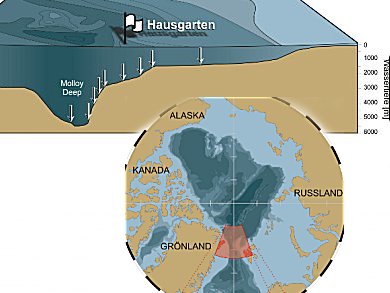Melanie Bergmann and Michael Klages, Alfred Wegener Institute for Polar and Marine Research, Bremerhaven, Germany, examined some 2100 seafloor photographs for waste. The photos were taken at a water depth of 2500 m, 1.5 m above the sea bed, near HAUSGARTEN, the deep-sea observatory of the Institute in the eastern Fram Strait. This is the sea route between Greenland and the Norwegian island Spitsbergen.
Waste, primarily plastic, can be seen in around 1 % of the footage of the images from 2002 and in around 2 % of those from 2011. 2 % is a lot, as the Arctic Ocean and especially its deep-sea areas have long been considered to be the most remote and secluded regions of our planet. The quantities observed were higher than those recorded from a deep-sea canyon not far from the industrialized Portuguese capital Lisbon. According to recent research, more plastic waste will accumulate in deep-sea canyons than in open slope environments such as HAUSGARTEN.
This increase might result from enormously increasing ship traffic since the ice cover has been continuously shrinking and getting thinner.
The main victims of the increasing contamination of the seafloor are the deep-sea inhabitants.
- Alfred Wegener Institute, Bremerhaven, Germany.
- Increase of litter at the Arctic deep-sea observatory HAUSGARTEN,
Melanie Bergmann, Michael Klages,
Marine Pollution Bulletin 2012.
DOI: 10.1016/j.marpolbul.2012.09.018




